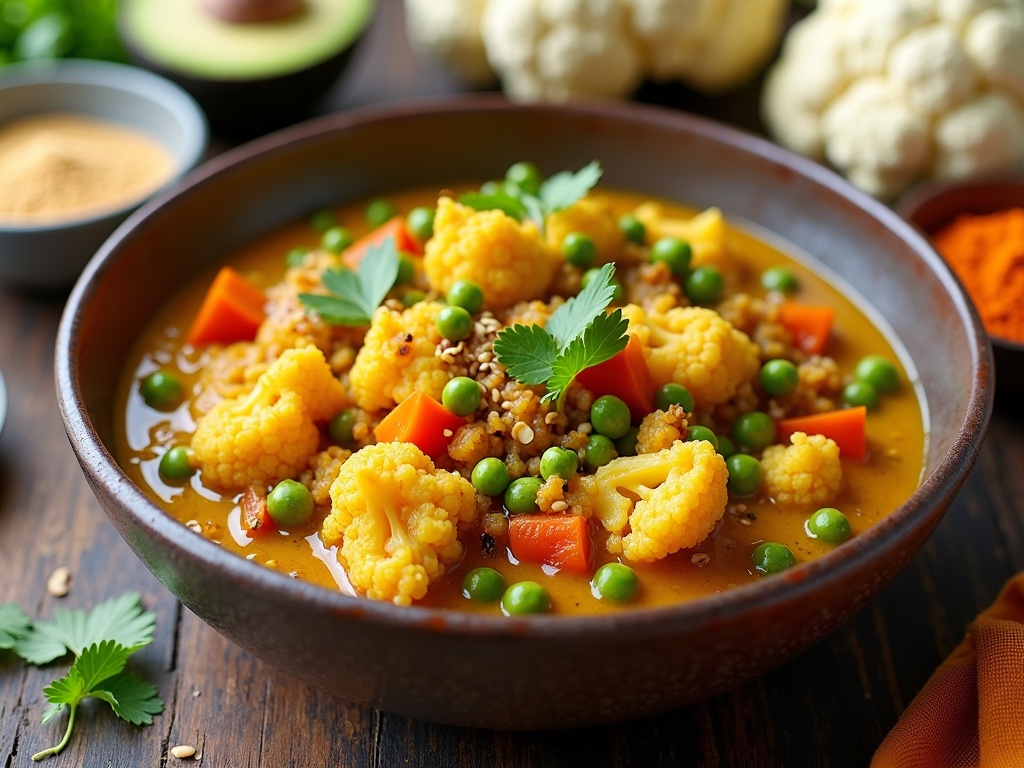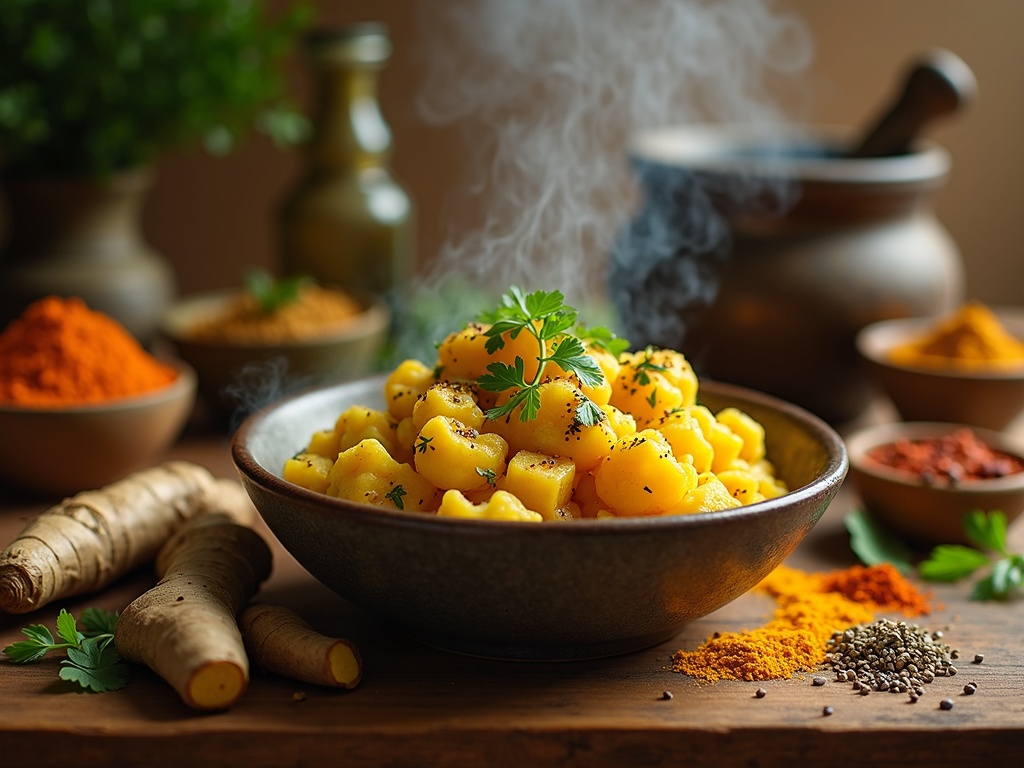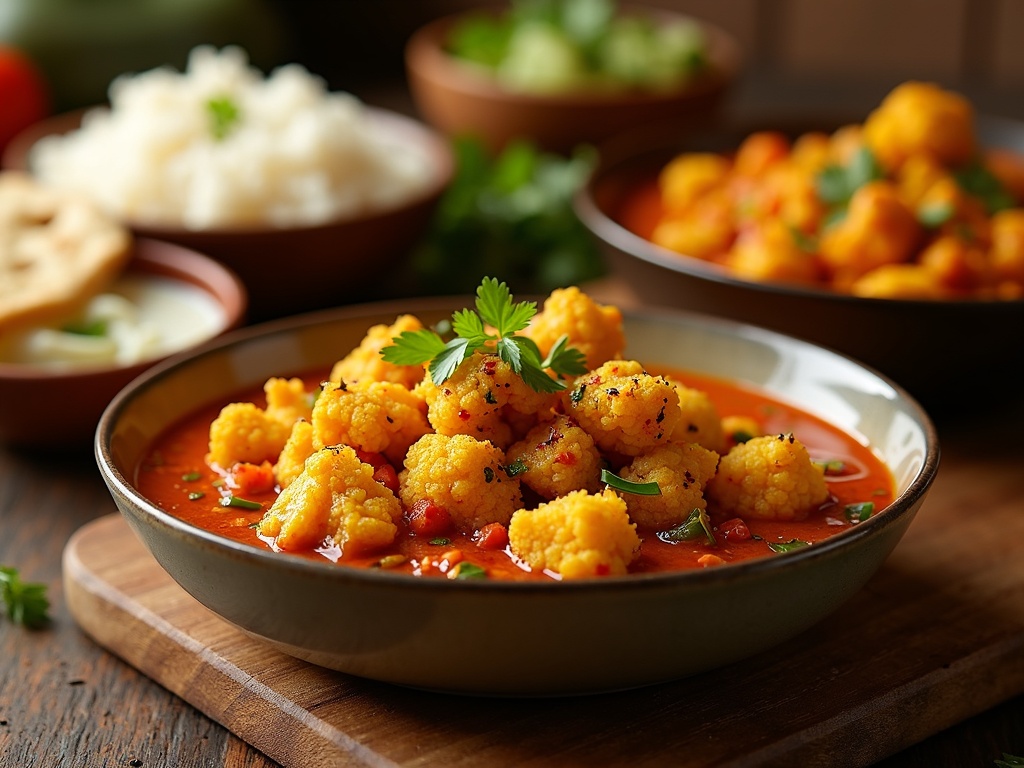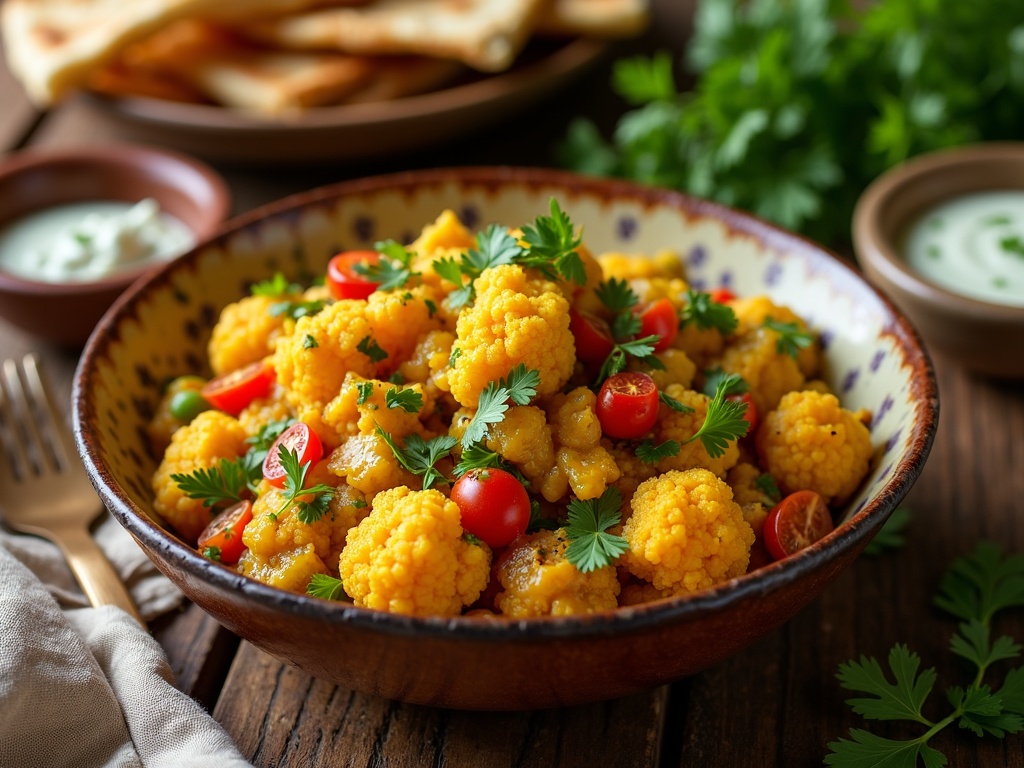Cauliflower curry stands as a nutritional powerhouse in South Asian cuisine, delivering exceptional flavor while cutting carbs compared to starchier options. This dish combines cauliflower’s cancer-fighting properties with healing spices like turmeric, cumin, and coriander that traditional medicine has valued for thousands of years.
Find In This Article
Key Takeaways
- Cauliflower curry is significantly lighter than potato-based versions, containing just 25 calories per cup while providing essential vitamins C, K, B6, potassium, and magnesium.
- The anti-inflammatory compounds in curry spices like turmeric (curcumin) and ginger (gingerol) offer proven health benefits supported by both traditional medicine and modern research.
- Preparing cauliflower curry is environmentally sustainable, requiring only 560 liters of water per kilogram compared to 15,000 liters for beef production.
- Popular variations include Aloo Gobi (with potatoes), spicy Gobi Masala, and vegan versions made with coconut milk instead of dairy products.
- For maximum flavor, consider roasting cauliflower before adding it to your curry, which adds depth through caramelization and creates a subtle smoky quality.
A Healthy and Flavorful South Asian Dish
I’ve discovered that cauliflower curry dishes represent some of the most nutritious options in South Asian cuisine. This traditional dish has earned its place on dinner tables across India, Pakistan, and Bangladesh for good reason – it packs incredible flavor while offering substantial health benefits.
Nutritional Powerhouse
Cauliflower delivers an impressive nutritional profile that makes it an excellent base for curry. A single cup contains just 25 calories while providing 2 grams of protein and 5 grams of carbohydrates. This makes it significantly lighter than potato-based curries, which can contain three to four times the calories and carbohydrates.
The nutritional benefits don’t stop there. Cauliflower is loaded with essential nutrients:
- Vitamin C for immune support and skin health
- Vitamin K for proper blood clotting and bone health
- Vitamin B6 that supports brain development and function
- Potassium to help regulate blood pressure
- Magnesium for muscle and nerve function
What’s particularly noteworthy is that a serving of cauliflower curry provides about 10% of your daily recommended fiber intake, supporting digestive health and helping you feel full longer.
Smart Substitution for Traditional Ingredients
I’ve found that replacing higher-carb ingredients with cauliflower creates meals that are just as satisfying but much lighter. For instance, while potatoes and peas are common curry ingredients, they contain significantly more carbohydrates and calories. A cup of potatoes has roughly 120 calories and 28 grams of carbs – making cauliflower dishes a smart alternative for those watching their carbohydrate intake.
The texture of cauliflower works perfectly in curry dishes because it absorbs the rich flavors of spices like turmeric, cumin, and coriander while maintaining a pleasing bite. Unlike some other low-calorie vegetables, cauliflower doesn’t become mushy when cooked properly, instead retaining a satisfying texture that can even mimic the heartiness of meat in some preparations.
For those looking to expand their cauliflower repertoire beyond curry, cauliflower cheese offers another delicious way to enjoy this versatile vegetable. The combination of cauliflower’s mild flavor with rich, savory elements makes it an incredibly adaptable ingredient across various cuisines.
This blend of nutrition, flavor, and versatility explains why cauliflower curry remains a beloved dish that has stood the test of time in South Asian cooking traditions while gaining popularity worldwide as a healthy meal option.
Powerful Health Benefits That Will Surprise You
Cauliflower has quickly become one of my favorite vegetables to include in vegetable curry recipes not just for its flavor but for its amazing health benefits. This humble vegetable packs a powerful nutritional punch that goes far beyond what many people realize.
Cancer-Fighting Properties and Heart Health
The cancer-fighting potential of cauliflower is quite remarkable. Studies show that cruciferous vegetables like cauliflower contain compounds called glucosinolates that, when broken down during cooking or digestion, form bioactive compounds with potential anti-cancer properties. These compounds may help inhibit the development of cancer cells and provide protection against several types of cancer.
I’ve found that including cauliflower in curries also supports heart health significantly. The high fiber content in cauliflower can reduce heart disease risk by approximately 15%. This happens because fiber helps lower cholesterol levels by binding to bile acids in the digestive system, forcing the body to pull cholesterol from the bloodstream to create more bile acids.
Cauliflower is loaded with powerful antioxidants that combat oxidative stress in your body. These antioxidants, including vitamin C and various phytonutrients, help neutralize harmful free radicals that can damage cells and contribute to chronic diseases and aging.
For digestive health, cauliflower is a superstar. Its fiber content supports healthy digestion and prevents constipation by adding bulk to stool and feeding beneficial gut bacteria. I’ve noticed that adding baked cauliflower or cauliflower curry to my weekly meal plan keeps my digestive system running smoothly.
If you’re watching your weight, cauliflower curry is an excellent choice. Cauliflower is naturally low in calories while being filling due to its high fiber and water content. One cup of cauliflower contains just about 25 calories, making it a perfect ingredient for satisfying meals without excess calories.
The nutritional profile of cauliflower is impressive. It contains:
- Vitamin C: A powerful immune booster (nearly 80% of your daily needs in one cup)
- Vitamin K: Essential for bone health and blood clotting
- B vitamins: Important for energy production and brain function
- Potassium: Helps regulate blood pressure
- Manganese: Supports metabolism and bone formation
- Folate: Critical for cell division and DNA synthesis
I’ve incorporated cauliflower cheese recipes and curries into my regular meal rotation after learning about these benefits. The versatility of cauliflower means you can enjoy these health advantages in numerous delicious ways.
The anti-inflammatory properties of cauliflower are another significant benefit. Chronic inflammation is linked to numerous health problems, from arthritis to heart disease. The compounds in cauliflower help reduce inflammation markers in the body, potentially lowering your risk of these conditions.
Cauliflower also supports detoxification processes in your body. The glucosinolates in cauliflower help activate detoxification enzymes and regulate their activity. This helps your body process and eliminate toxins more efficiently.
For brain health, cauliflower contains choline, an essential nutrient that many people don’t get enough of. Choline is important for brain development, nervous system function, and cellular maintenance. It also helps prevent the buildup of homocysteine in the blood, which has been linked to cognitive decline.
When preparing cauliflower curry, I aim to cook it lightly to preserve the maximum nutritional benefits while still developing those rich, complex flavors that make curry so satisfying. The combination of cauliflower with curry spices like turmeric (which has its own impressive anti-inflammatory properties) creates a truly health-promoting dish.

Healing Spices That Make This Curry Special
I’ve discovered that the magic of a good vegetable curry isn’t just in its taste but also in the healing properties of its spices. When making cauliflower curry, I’m not just creating a delicious meal – I’m also harnessing centuries of traditional medicine in every aromatic spoonful.
The Core Healing Spices
Turmeric stands as the golden champion in curry spices. Its active compound, curcumin, offers powerful anti-inflammatory benefits that can help reduce joint pain and swelling. In traditional Ayurvedic medicine, turmeric has been used for over 4,000 years to treat various conditions from respiratory issues to skin diseases. Recent scientific research has confirmed many of these traditional uses, with studies showing curcumin can help manage inflammatory conditions and potentially even support brain health.
Cumin seeds add more than just a warm, earthy flavor to your baked cauliflower dishes. They’re packed with iron and can enhance digestion by stimulating enzyme production. Traditional medicine systems have long valued cumin for its ability to boost immune function and relieve bloating. Modern research supports these claims, with studies indicating that cumin can help improve digestion and has antimicrobial properties that support overall gut health.
Coriander (both the seeds and fresh leaves) brings a citrusy brightness to cauliflower curry while helping regulate blood sugar levels. This makes it particularly valuable for those monitoring their glucose. In traditional medicine practices across India and the Middle East, coriander has been used to treat everything from anxiety to digestive discomfort. Scientific studies have shown coriander extract can indeed help lower blood sugar levels and has antioxidant properties that protect cells from damage.
Ginger root adds a spicy warmth that does more than wake up your taste buds. It contains gingerol compounds that provide remarkable anti-nausea benefits and support healthy digestion. For centuries, ginger has been a go-to remedy for motion sickness, morning sickness, and general stomach upset across Asian medicinal traditions. Contemporary research confirms ginger’s effectiveness for nausea relief and indicates it may also have anti-inflammatory and pain-relieving properties.
Incorporating These Spices Effectively
To maximize the healing benefits of these spices in your cauliflower cheese recipe or curry, I recommend these practical approaches:
- Bloom spices in oil at the beginning of cooking to release their fat-soluble compounds
- Combine turmeric with black pepper to enhance curcumin absorption by up to 2,000%
- Use fresh ginger rather than dried when possible for higher levels of active compounds
- Toast whole cumin and coriander seeds before grinding for maximum flavor and benefit
- Create a balanced blend where no single spice overwhelms the others
The effectiveness of these spices isn’t just folklore – scientific validation continues to mount. A 2019 review in the International Journal of Molecular Sciences confirmed turmeric’s anti-inflammatory effects, while research published in Food and Chemical Toxicology demonstrated cumin’s impressive antioxidant profile.
These healing spices don’t just make cauliflower curry delicious – they transform it into a functional food that nourishes on multiple levels. The next time you prepare this dish, remember you’re participating in a culinary tradition that bridges ancient wisdom and modern nutritional science. The beautiful golden color, complex aroma, and depth of flavor are simply bonuses to the remarkable health benefits simmering in your pot.

Popular Variations to Try at Home
I’ve found that the beauty of cauliflower curry lies in its versatility. With just a few tweaks to ingredients or cooking techniques, you can create completely different flavor profiles. Let me share some fantastic variations you can easily make in your kitchen.
Delicious Curry Variations
Aloo Gobi stands as one of the most beloved cauliflower curry variations. This traditional dish combines potatoes and cauliflower in a fragrant blend of spices. The starchy potatoes complement the tender cauliflower perfectly, creating a satisfying texture contrast. I typically add cumin seeds, turmeric, and garam masala for that authentic flavor. The potatoes absorb the spices beautifully while the cauliflower maintains a slight bite.
If you prefer something with more heat, Gobi Masala might be your new favorite. This spicier version features a rich, tomato-based sauce that clings to each floret. I add extra chili powder and perhaps a minced green chili for that extra kick. The sauce is thicker and more abundant than in Aloo Gobi, making it perfect for scooping up with bread.
For those following plant-based diets, a Vegan Cauliflower Curry offers all the flavor without any animal products. Replace ghee with coconut oil and use coconut milk instead of cream or yogurt. The coconut milk adds a subtle sweetness that balances the spices beautifully. I like adding chickpeas for protein and extra texture.
Your cooking method can significantly impact the final result of your curry. Stovetop cooking gives you the most control, allowing you to adjust heat and monitor the cauliflower’s texture. For busy weeknights, a pressure cooker cuts cooking time dramatically – just be careful not to overcook the cauliflower, as it can become mushy.
Slow cookers work wonders for developing deep flavors when you have time to spare. The gentle, consistent heat allows the spices to bloom fully. I set mine in the morning and come home to an aromatic curry ready for dinner.
Looking to elevate your cauliflower curry flavor? Try roasting the florets before adding them to the curry. This simple step adds incredible depth through caramelization. I toss the cauliflower with oil and spices then roast at 425°F for about 20 minutes until the edges start to brown. The slightly charred bits add a smoky quality that transforms the entire dish.
When it comes to serving, basmati rice makes a classic pairing, absorbing all those delicious curry juices. For something heartier, try serving with warm naan bread – perfect for scooping up every last bit of sauce. If you’re watching carbs, cauliflower rice creates a double-cauliflower experience, or quinoa offers a protein-packed alternative.
For a complete meal, I like to add a side of cooling cucumber raita. The yogurt-based condiment balances the heat from the curry and adds a refreshing element to each bite. A simple cucumber and tomato salad with lemon juice also works beautifully.
Don’t forget that cauliflower recipes can be adapted to your spice preference. If you’re cooking for both spice lovers and those with milder palates, prepare a base curry on the gentler side, then offer chopped fresh chilies or chili oil for people to add according to their taste.
With these variations in your cooking arsenal, cauliflower curry will never get boring. Each version brings its own unique character while celebrating this versatile vegetable in delicious new ways.

Why It’s Good for the Planet
Cauliflower curry isn’t just a flavorful dish—it’s a choice that makes a significant positive impact on our environment. When I look at sustainable food options, cauliflower stands out as an exceptional ingredient that helps reduce my ecological footprint while still enjoying a satisfying meal.
The environmental benefits of cauliflower are quite impressive when you examine the resources needed for its production. This versatile vegetable requires only 560 liters of water per kilogram to grow—a remarkably efficient use of one of our planet’s most precious resources. To put this in perspective, beef production demands a staggering 15,000 liters of water per kilogram. By choosing plant-based curry dishes featuring cauliflower, I’m helping conserve thousands of liters of water with each meal.
Environmental Impact of Cauliflower vs. Animal Products
Beyond water conservation, cauliflower offers several other environmental advantages:
- Land efficiency: Cauliflower cultivation requires significantly less land than raising animals for meat, allowing more food to be produced in smaller areas.
- Lower carbon emissions: The production, processing, and transportation of cauliflower generates fewer greenhouse gases compared to animal proteins.
- Reduced pollution: Plant-based farming typically involves fewer chemical inputs and produces less waste than industrial animal agriculture.
- Soil preservation: Proper crop rotation with vegetables like cauliflower can help maintain soil health and fertility.
I’ve found that making cauliflower-based dishes a regular part of my meal planning has been an effective way to reduce my personal environmental impact. Each time I prepare a cauliflower curry instead of a meat-based meal, I’m making a choice that requires less water, less land, and produces fewer greenhouse gases.
The beauty of cauliflower curry lies in its ability to deliver satisfying, complex flavors while being gentle on the planet. The creamy texture of cauliflower absorbs aromatic spices perfectly, creating a dish that’s both environmentally responsible and culinary impressive. When I serve cauliflower recipes to friends and family, I’m proud of the delicious meal and the sustainable choice it represents.
Making small changes to our eating habits can add up to meaningful environmental benefits. By incorporating more plant-focused meals like cauliflower curry into my routine, I’ve found a practical way to align my food choices with my environmental values. The fact that these dishes are also budget-friendly, nutritious, and delicious makes the decision even easier.
As climate concerns become increasingly urgent, our individual food choices matter more than ever. Cauliflower curry represents the kind of thoughtful eating that balances personal enjoyment with planetary health—a delicious compromise that doesn’t feel like a sacrifice at all. By choosing ingredients with lower environmental impacts, I can enjoy vibrant, flavorful meals while knowing my food choices are helping to protect natural resources for future generations.

Sources:
Journal of Food Composition and Analysis, Nutrients Journal, Healthline, Food and Water Watch, American Journal of Lifestyle Medicine

